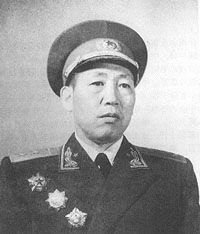
Nie Rongzhen was a Marshal of the People's Republic of China. He died as the last People's Liberation Army (PLA) marshal.

Xu Xiangqian was a Marshal of the People's Republic of China (PRC). He was the son of a wealthy landowner, but joined the Kuomintang's (KMT) National Revolutionary Army (NRA), against his parents' wishes, in 1924. When the Chinese Civil War started in 1927, Xu joined the Eyuwan Soviet led by Zhang Guotao; Xu became commander of the Eyuwan-based Fourth Red Army. Zhang and Xu retreated to northern Sichuan after being defeated by a KMT encirclement campaign. Xu politically survived Zhang's defection to the KMT in the late-1930s; he rejoined the Red Army in a less senior position under the leadership of Mao Zedong.

The Nanchang Uprising was the first major Nationalist Party of China–Chinese Communist Party engagement of the Chinese Civil War, begun by the Chinese Communists to counter the Shanghai massacre of 1927 by the Kuomintang.
Yuanshuai was a Chinese military rank that corresponds to a marshal in other nations. It was given to distinguished generals during China's dynastic and republican periods. A higher level rank of Dayuanshuai, which corresponds to generalissimo was awarded to Chiang Kai Shek of the Republic of China. It was also proposed for Mao Zedong on the mainland, but he ultimately never accepted it.
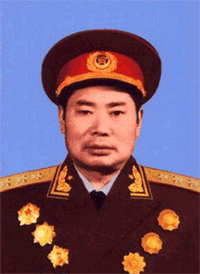
Yang Dezhi was a Chinese general and politician. He was senior military officer in the North China Field Army, a veteran of the Korean War and commander in China during the Sino–Vietnamese War.

Wang Yaowu was a high-ranking KMT general and the Governor of Shandong Province who successfully fought against both the Imperial Japanese Army and the Chinese Communists. In September 1948, Communist forces launched the Battle of Jinan. Wang was captured and held as a prisoner of war until his pardon and release in 1959. During the Cultural Revolution he came under attack by the Red Guards for being a former nationalist commander and died of a heart attack in 1968.

Shi Yousan was a Chinese general of the National Revolutionary Army who served as the 9th Governor of the Chahar and 3rd Governor of Anhui provinces during the Republican era of China.
The 9th Central Committee of the Chinese Communist Party was in session from 1969 to 1973. It was preceded by the 8th Central Committee of the Chinese Communist Party. It was the second central committee in session during the Chinese Cultural Revolution. Even amidst partial cultural disintegration, it was succeeded by the 10th Central Committee of the Chinese Communist Party. It held two plenary sessions in the 4-year period.
The 7th Central Committee of the Chinese Communist Party was in session from 1945 to 1956. It was a product of the convening of the 7th National Congress of the Chinese Communist Party. It held six plenary sessions in this 11-year period. It began in June 1945, before the end of the Second Sino-Japanese War, and the resumption of the Chinese Civil War. This committee would be succeeded by the 8th Central Committee.
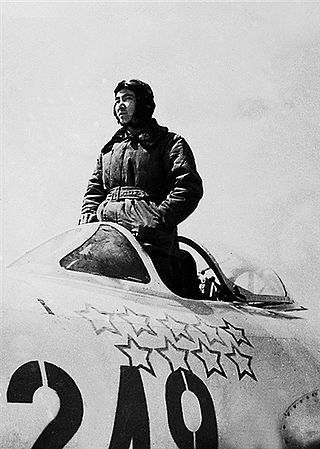
Wang Hai was a Chinese fighter pilot and general. A flying ace of the Korean War, he served as commander of the People's Liberation Army Air Force (PLAAF) from 1985 to 1992. He was awarded the rank of general in 1988.
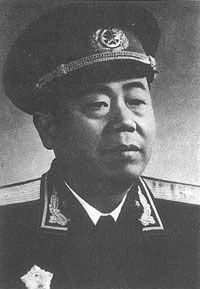
Nie Fengzhi was a general of the People's Liberation Army Air Force (PLAAF) of the People's Republic of China.

Zhang Yunyi, was a Communist revolutionary and military strategist of the People’s Republic of China. Born in Wenchang, Hainan, he joined the Chinese Communist Party in 1926, and took part in the Northern Expedition, the Nanchang Uprising, the Baise Uprising, the Second Sino-Japanese War and the Chinese Civil War. Zhang held the posts of the army commander of the 7th Red Army, the assistant staff officer of the Military Commission of the Central Committee of the CCP, the commander of a military area, etc., and was named one of the ten Senior Generals in 1955. The Zhang Yunyi Memorial Hall is located in Wenchang, Hainan Province.
Wang Jianping is a former general of the People's Liberation Army (PLA) of China. He served as commander of the People's Armed Police and deputy chief of General Staff of the People's Liberation Army. He was dismissed in 2016 and placed under investigation for corruption. He was a member of the 18th Central Committee of the Chinese Communist Party.

Qiu Huizuo was a lieutenant general of the People's Liberation Army (PLA), best known as one of the "four guardian warriors" of Vice Chairman Lin Biao during the Cultural Revolution. Qiu rose through the ranks of the PLA during the civil war between the Chinese Communist Party and the Kuomintang. He took charge as the PLA logistics chief in 1959, and was persecuted at the beginning of the Cultural Revolution. He was later rehabilitated owing to the blessing of Zhou Enlai and Lin Biao, and elevated to the Politburo of the Chinese Communist Party in 1969. In return, he helped to persecute Lin's enemies and consolidate Lin's power in the PLA. After Lin's flight and death in 1971, Qiu was purged and sentenced to 16 years in prison.

Zhang Tingfa was a Chinese Communist revolutionary and a major general of the People's Liberation Army Air Force (PLAAF). He served as Political Commissar and Commander of the PLAAF, and was a member of the Central Military Commission (CMC). He also served two terms as a member of the Politburo of the Chinese Communist Party, before retiring in 1985. He fought in the Second Sino-Japanese War, the Chinese Civil War, and the Korean War, and commanded the Chinese Air Force during the Sino-Vietnamese War.
Decisive Engagement: The Liaoxi-Shenyang Campaign is a 1991 Chinese epic war film directed by Li Jun, Yang Guangyuan, Wei Lian, Cai Jiwei, Zhao Jilie, Zhai Junjie and Jing Mukui, written by Li Pingfen, Shi Chao and Wang Jun, and starring Gu Yue, Su Lin, Ma Shaoxin, Lu Jixian, Zhao Hengduo, and Wu Zhiyuan. The film premiered in China on January 1, 1992. The film is about the Liaoshen Campaign of the Chinese Civil War.
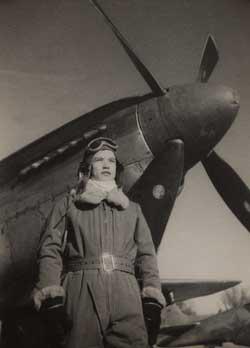
Lin Hu was a Chinese aviator, fighter pilot and lieutenant general of the People's Liberation Army Air Force (PLAAF). Born to a Russian mother and a Chinese father, he was orphaned at a young age. Lin joined the Eighth Route Army to fight in the Second Sino-Japanese War before he turned 11. After the Second World War, he was trained as a fighter pilot and fought in the Korean War and the Second Taiwan Strait Crisis. He served as deputy commander of the PLA Air Force from 1985 to 1994 and attained the rank of lieutenant general in 1988.
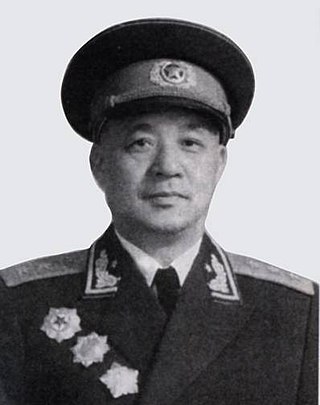
Wing Wang Jian'an was a Chinese military official and general in the People's Liberation Army.

Ma Ning was a Chinese Communist revolutionary and major general of the People's Liberation Army Air Force (PLAAF). A decorated army veteran of the Second Sino-Japanese War and the Chinese Civil War, he transferred to the Air Force after being handicapped by battle wounds. He trained to become a bomber pilot and fought in the Battle of Yijiangshan Islands. He rose rapidly during the Cultural Revolution, and was appointed Commander of the PLAAF in 1973 following the Lin Biao incident. After the end of the Cultural Revolution in 1976, he was removed from the command for his association with the radical Gang of Four.
Wang Chengbin is a lieutenant general (zhongjiang) of the People's Liberation Army (PLA). He was a member of the 13th and 14th Central Committee of the Chinese Communist Party.
